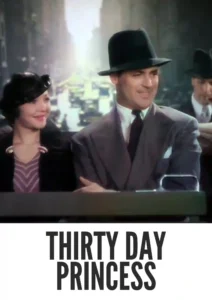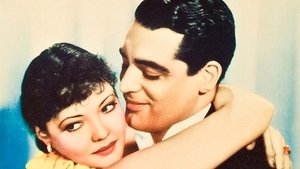Video Sources 0 Views
- Thirty Day Princess 1934 Colorized


Synopsis
Table of Contents
ToggleRoyalty, Romance, and a Grand Deception: Thirty Day Princess (1934) in Vibrant Color

Step back in time with Thirty Day Princess, a delightful screwball comedy from 1934, now beautifully colorized for a modern viewing experience. Starring Sylvia Sidney and Cary Grant, this film offers a charming blend of romance and humor as a look-alike takes the place of a princess. Perfect for fans of classic comedies and those seeking a light-hearted escape, this HD download brings a touch of old Hollywood glamour to your screen.
Thirty Day Princess Storyline: A Royal Switch
Thirty Day Princess tells the story of Nancy Lane (Sylvia Sidney), an aspiring actress who bears a striking resemblance to Princess Catterina (also played by Sylvia Sidney), a visiting royal from a small European country. When the princess falls ill, Nancy is hired to impersonate her for thirty days to ensure a crucial diplomatic agreement goes smoothly.As Nancy navigates the world of high society, she meets and falls in love with a charming newspaper editor, Walter Graham (Cary Grant), who is initially skeptical of the princess’s behavior. A series of comedic mishaps and romantic entanglements ensue as Nancy tries to maintain her charade while also pursuing her feelings for Walter. The film culminates in a heartwarming resolution, where true identities are revealed, and love prevails. Ultimately, Thirty Day Princess is a delightful and entertaining romantic comedy that showcases the charm and wit of its stars.
Movie Cast
The film features a talented cast of actors who bring this enchanting story to life:
- Sylvia Sidney as Princess Catterina / Nancy Lane
- Cary Grant as Walter Graham
- Edward Arnold as Richard Pavloff
- Henry Stephenson as King Anatole
- Vince Barnett as Photographer
Movie Genre
Thirty Day Princess falls into the genre of screwball comedy, with elements of romance and satire that are characteristic of the era. Its lighthearted plot and witty dialogue make it a delightful and engaging film.
Historical Context: The Golden Age of Hollywood Comedy
Released in 1934, Thirty Day Princess represents a highlight of the Golden Age of Hollywood comedy, showcasing the era’s wit, charm, and sophisticated humor. The film was produced during a time when Hollywood was at its peak, creating timeless classics that continue to entertain audiences today. Thirty Day Princess stands out as a shining example of the genre, offering a glimpse into the cultural and social landscape of the 1930s.
Colorization Details
This colorized version of Thirty Day Princess has been meticulously restored using modern digital techniques, enhancing the visual appeal while preserving the film’s original charm and elegance. The colorization process involved carefully analyzing the grayscale tones of the original black and white footage and assigning appropriate colors to each scene. While the specific software used remains proprietary, the techniques employed included advanced algorithms for color palette selection and image enhancement. This painstaking process brings new life to the characters and settings, making the story even more engaging for modern audiences. While some may debate the merits of colorizing classic films, it introduces these films to a broader audience, ensuring their legacy for future generations.
Technical Details
- Director: Marion Gering
- Screenplay: Preston Sturges, Frank Partos, Walter DeLeon
- Story: Clarence Budington Kelland
- Cinematography: Leon Shamroy
- Edited by: Paul Weatherwax
- Production Company: Paramount Pictures
- Distributed by: Paramount Pictures
- Runtime: 75 minutes
Technical Specifications
- Download Format: MP4
- Resolution: HD (1080p)
- Compatibility: Compatible with most devices, including smartphones, tablets, computers, and smart TVs.
Reviews and Critical Reception
Thirty Day Princess (1934) is celebrated for its witty script, charming performances, and lighthearted approach to romance and royalty. The film is a testament to the talents of its cast and crew, offering a delightful escape into the world of classic Hollywood comedy. As a beloved film from the Golden Age of Hollywood, Thirty Day Princess continues to captivate audiences with its timeless appeal.
FAQs
- Q: What is Thirty Day Princess about?
- A: Thirty Day Princess is a screwball comedy about an actress who impersonates a princess for thirty days.
- Q: Is Thirty Day Princess (1934) a well-known classic film?
- A: Thirty Day Princess is a beloved film from the Golden Age of Hollywood, known for its charm and wit.
- Q: Is this version of Thirty Day Princess colorized?
- A: Yes, this version has been professionally colorized to enhance the viewing experience.
- Q: What makes Thirty Day Princess enjoyable for classic film fans?
- A: Thirty Day Princess offers a delightful escape into the world of classic Hollywood comedy, with witty dialogue and charming performances.
- Q: What is the download format?
- A: The download format is MP4, which is compatible with most devices.
- Q: What resolution is the download?
- A: The resolution is HD (1080p), providing a high-quality viewing experience.
Download Now in HD!
Watch Thirty Day Princess Today!











